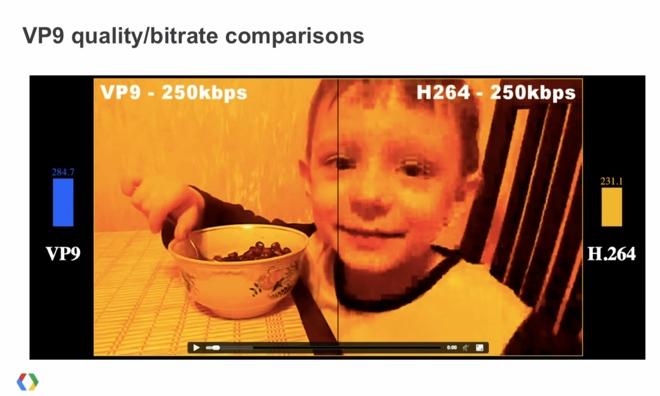While VP8, Google's initial attempt at a royalty-free video codec, failed to gain much traction, the search giant is now focusing its efforts on ultra-high-resolution 4K video with its new VP9 codec, with a large-scale unveiling with YouTube multiple hardware partners set to take place next week, according to a new report.
At next week's Consumer Electronics Show in Las Vegas, Nev., Google is expected to debut the new VP9 codec as an alternative to H.265, capable of streaming 4K video on YouTube with fewer bandwidth needs, according to GigaOm. The company is said to already have a slew of hardware partners that have pledged support, including ARM, Intel, Broadcom, Marvell, Nvidia, Samsung, Sony, Sharp and Toshiba.
Unsurprisingly not among the list of initial hardware supporters: Apple.
The successor to VP8 has been in development at Google for some time, and the company has suggested its intention is not to completely replace H.265. Instead, Google says it hopes to create a royalty-free alternative that would ease bandwidth issues associated with 4K video content on its popular streaming site YouTube.
Francisco Varela, global director of platform partnerships at YouTube, dismissed speculation that VP9 versus H.264 would be "war of the video codecs." He suggested that YouTube could add support for H.265 in the future, alongside VP9.
Varela claimed YouTube's main goal is to reduce the amount of data necessary to stream ultra-definition 4K video. The new VP9 codec aims to reduce bandwidth necessary by half, and went as far as to predict that YouTube users will be "surprised" whenever a video has to stop to buffer by 2015.
Google last attempted to push its own royalty-free codec in 2010, when the company announced its WebM format, also known as VP8. That codec was acquired by Google as part of the technology portfolio of On2.
Critics, however, contended that VP8 offered no real advantages over its established alternative, H.264, aside from being royalty free. Apple, for example, opted to stick with H.264 and continue paying the low royalty fees, rather than embrace VP8.
Google was later forced to settle a patent dispute with MPEG LA, the group that manages the licensing of H.264 patents, over its use of VP8. That meant that although VP8 was initially pushed as a "free" alternative to H.264, Google had instead begun paying licensing fees for related streaming video patents.
 Neil Hughes
Neil Hughes







-m.jpg)






 Charles Martin
Charles Martin
 Christine McKee
Christine McKee
 Wesley Hilliard
Wesley Hilliard
 Malcolm Owen
Malcolm Owen
 Andrew Orr
Andrew Orr
 William Gallagher
William Gallagher
 Sponsored Content
Sponsored Content








164 Comments
I guess it will be a nice sort of academic exercise to see YouTube choke and stall on another codec for a change.
YouTube has turned into garbage.
Demonstrating V9 against H.264 speaks volumes to the disigenuous nature of Google. Compare it to H.265: we know the outcome--inferior.
Any way of telling these fuckers to mind there own and not put H.265 six feet under? Truly 80's Microsoft all over again.
So what other code did Google steal to make VP9 4K? You know they stole something. Epic fail nonetheless.
So what other code did Google steal to make VP9 4K? You know they stole something. Epic fail nonetheless.
And what sort of data mining code did they include in this VP9 codec? You know damn good and well Google never does anything without insuring themselves an advertising revenue stream.